Exploring a Novel Therapeutic Frontier for Autism Spectrum Disorder
As autism spectrum disorder (ASD) continues to affect a significant number of children worldwide, families and professionals are constantly seeking innovative therapies to enhance social, communicative, and behavioral outcomes. Among these, Equine-Assisted Activities and Therapies (EAAT), including therapeutic horseback riding (THR), have garnered attention for their potential benefits. This article delves into the growing body of research on equine therapy as a supportive intervention for children with ASD, exploring how interactions with horses may complement traditional behavioral therapies like Applied Behavior Analysis (ABA). We will examine scientific findings, practical implications, and the future outlook of this unique therapeutic approach.
Understanding Equine-Assisted Activities and Therapies (EAAT)

What Are Equine-Assisted Activities and Therapies?
Equine-Assisted Activities and Therapies (EAAT) encompass a range of interventions involving horses designed to promote physical, emotional, and social well-being. These activities typically engage participants in horseback riding and horse-related interactions to support therapeutic goals.
Types of Equine Therapy Including Therapeutic Horseback Riding (THR)
One well-studied form of EAAT is Therapeutic Horseback Riding (THR), which involves riding lessons tailored to improve specific outcomes. THR has been extensively researched in children with autism spectrum disorder (ASD), demonstrating notable benefits in behavior and social functioning. Other EAAT interventions also incorporate horse care activities and interactive exercises alongside riding.
How EAAT Relates to Autism Treatment
Equine therapy has gained attention as a supplementary treatment for children with ASD due to its potential positive effects on social interaction, communication, and behavioral regulation. For example, THR programs have been linked to significant improvements in irritability, hyperactivity, and social communication skills. EAAT’s interactive nature may reduce stress and anxiety in youth with ASD, promoting better emotional regulation and engagement.
Overall, EAAT offers a holistic, engaging therapeutic option that supports multiple developmental domains in children with ASD, making it a promising complementary intervention in autism treatment.
Core Benefits of EAAT for Children with ASD
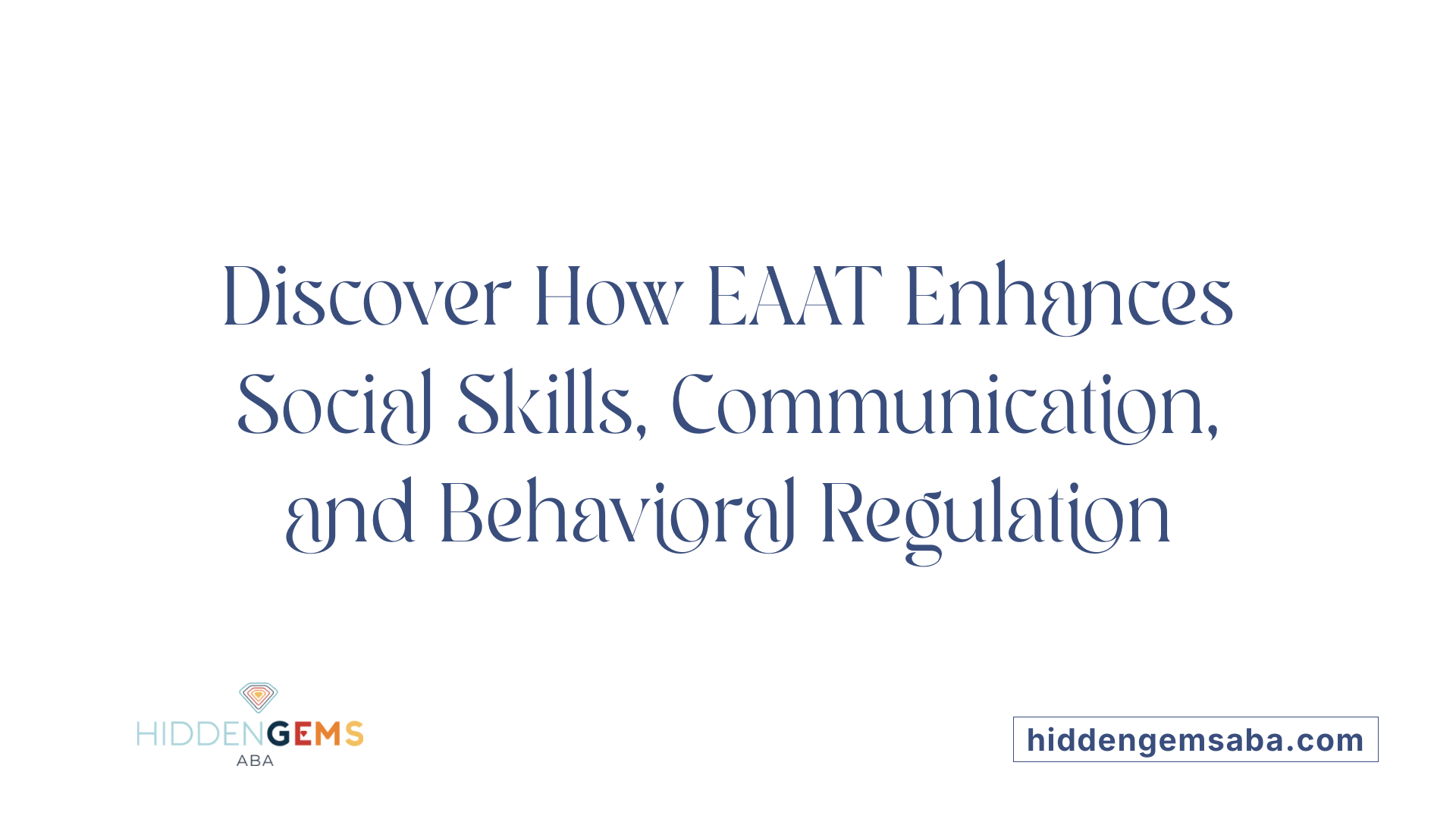
How Does EAAT Improve Social Functioning?
Equine-Assisted Activities and Therapies (EAAT) have demonstrated meaningful improvements in the social functioning of children with Autism Spectrum Disorder (ASD). Meta-analyses reveal enhanced social cognition and interaction skills following EAAT participation. Parents and therapists report increased engagement, better emotional regulation, and adaptive social behaviors, helping children with ASD navigate social environments more effectively.
What Are the Effects on Communication Skills?
EAAT programs contribute to noticeable enhancements in communication abilities, including both receptive and expressive language skills. Some studies observed that children participating in therapeutic horseback riding (THR) increased their spoken words and improved overall communication over time. The sustained effects up to six months post-intervention highlight the potential for long-term benefits in language development.
Can EAAT Help with Behavioral Regulation?
Behavioral regulation improves significantly with EAAT, particularly reductions in irritability and hyperactivity. A large randomized controlled trial involving 116 children aged 6-16 years reported marked decreases in these challenging behaviors after 10 weeks of THR. Follow-ups suggested these positive changes, especially irritability reduction, persisted for at least six months. Physiological measures such as lowered cortisol levels further support the calming, stress-reducing influence of EAAT on children with ASD.
Common Assessment Tools Used
| Tool Name | Purpose | Notes |
|---|---|---|
| Social Responsiveness Scale (SRS) | Measures social impairment severity | Widely used in ASD EAAT studies |
| Aberrant Behavior Checklist-Community (ABC-C) | Assesses irritability and hyperactivity | Key in measuring behavioral changes post-EAAT |
| Vineland Adaptive Behavior Scales | Evaluates adaptive behaviors | Useful in tracking general functional improvements |
Overall, EAAT offers a promising supplementary therapy for enhancing social, communication, and behavioral functioning in children with ASD, though more rigorous studies are needed to strengthen evidence.
Behavioral and Emotional Regulation through Equine Therapy
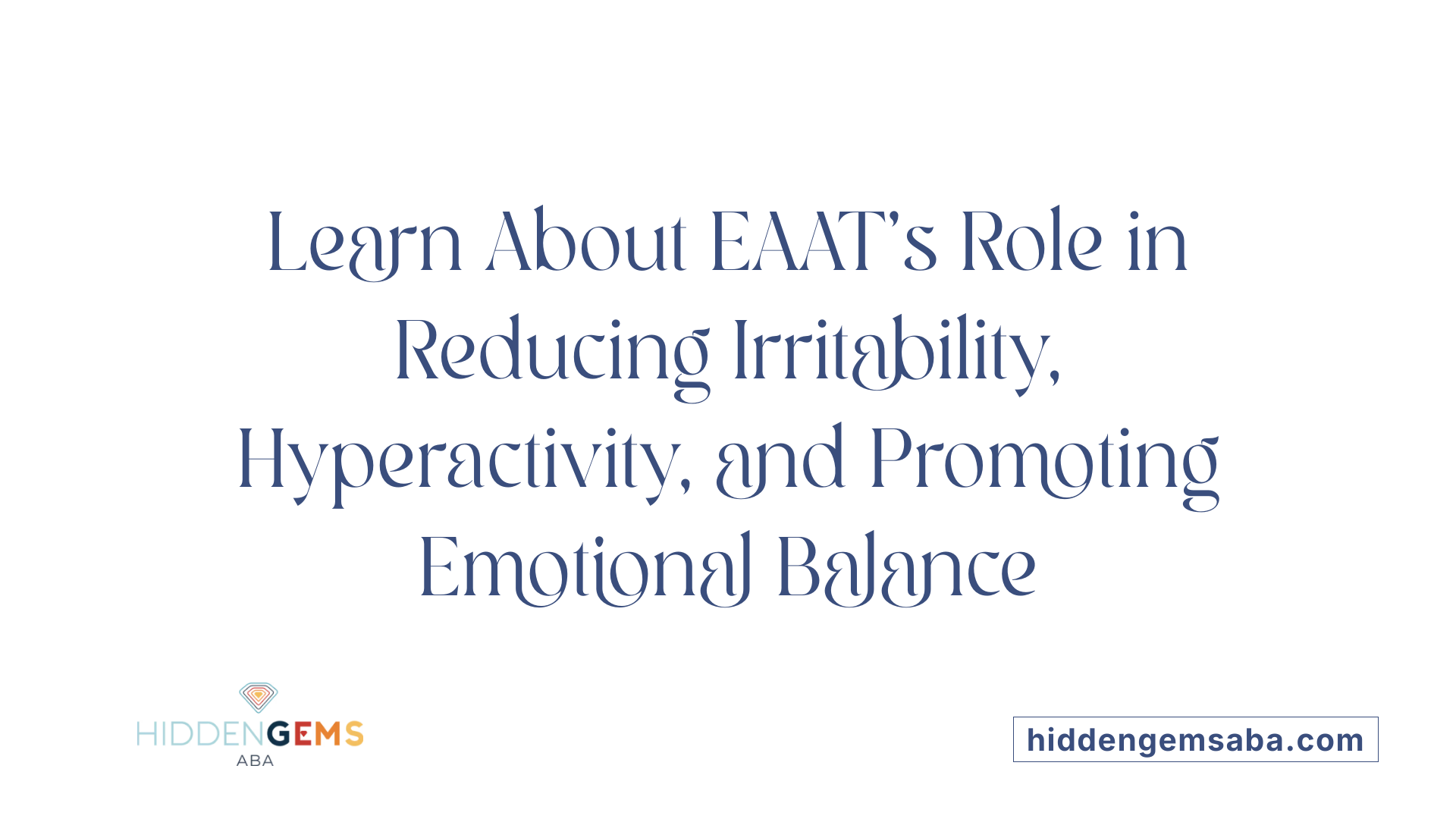
Reduction in irritability and hyperactivity
Equine-Assisted Activities and Therapies (EAAT), including Therapeutic Horseback Riding (THR), have demonstrated notable reductions in irritability and hyperactivity among children with Autism Spectrum Disorder (ASD). A significant randomized controlled trial involving 116 children aged 6 to 16 revealed that after 10 weeks of THR, participants showed marked decreases in these challenging behaviors. These improvements were measured using the Aberrant Behavior Checklist-Community (ABC-C), confirming the therapy's effectiveness in behavioral regulation.
Improvements in emotional regulation and adaptive behaviors
Beyond reducing hyperactivity, EAAT facilitates enhancements in emotional regulation and adaptive behaviors. Children engaged in these programs exhibit better social interactions and increased emotional control, as observed in standardized assessments and qualitative reports. The Vineland Adaptive Behavior Scales and the Social Responsiveness Scale (SRS) often detect these positive changes, highlighting EAAT's role in supporting emotional well-being and daily functioning.
Long-term maintenance of behavioral gains
Importantly, some behavioral improvements gained through EAAT and THR appear to be sustained over time. Follow-up data from the aforementioned RCT demonstrated that reductions in irritability and gains in social and communication skills, including increased verbal expression, persisted for at least six months post-intervention. These findings suggest that equine therapy may have lasting effects on emotional and behavioral regulation in youth with ASD, potentially by reducing arousal and stress levels, as evidenced by physiological markers like cortisol.
This evidence positions EAAT as a promising complementary intervention to address emotional and behavioral challenges prevalent in ASD, though ongoing research is necessary to further validate and expand these results.
Language Development Gains from EAAT
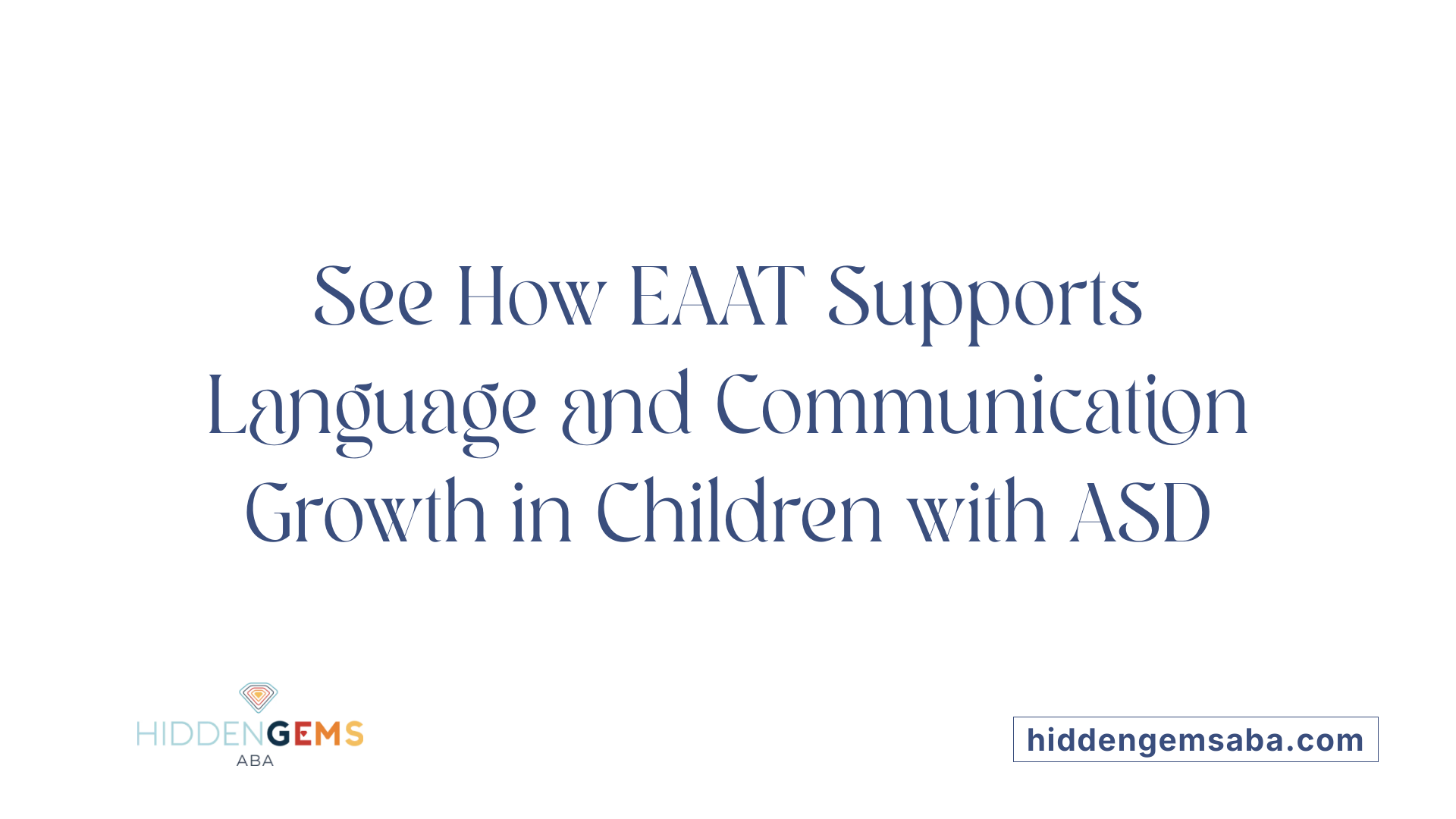
How does Equine-Assisted Activities and Therapies (EAAT) improve language skills in children with ASD?
Equine-Assisted Activities and Therapies (EAAT) have shown promising effects in enhancing language development among children with Autism Spectrum Disorder (ASD). Several studies report improvements in both receptive and expressive language abilities following participation in EAAT programs.
Receptive language refers to the ability to understand and process language, while expressive language involves using words and sentences to communicate effectively. EAAT’s structured and engaging environment allows children with ASD to practice these skills in a naturalistic and motivating setting.
Research indicates that after completing EAAT interventions, some children demonstrate noticeable gains in their vocabulary, sentence construction, and overall communication. These enhancements are believed to stem from the social interaction opportunities and the multisensory experiences provided during therapeutic horseback riding sessions.
For example, children participating in Therapeutic Horseback Riding (THR) showed increases in the number of words spoken and improved social communication behaviors sustained over at least six months post-intervention. Although further research is necessary due to variability in study designs and sample sizes, current evidence supports that EAAT can serve as a beneficial complementary therapy for developing language skills in children with ASD.
Motor and Sensory Function Improvements with EAAT
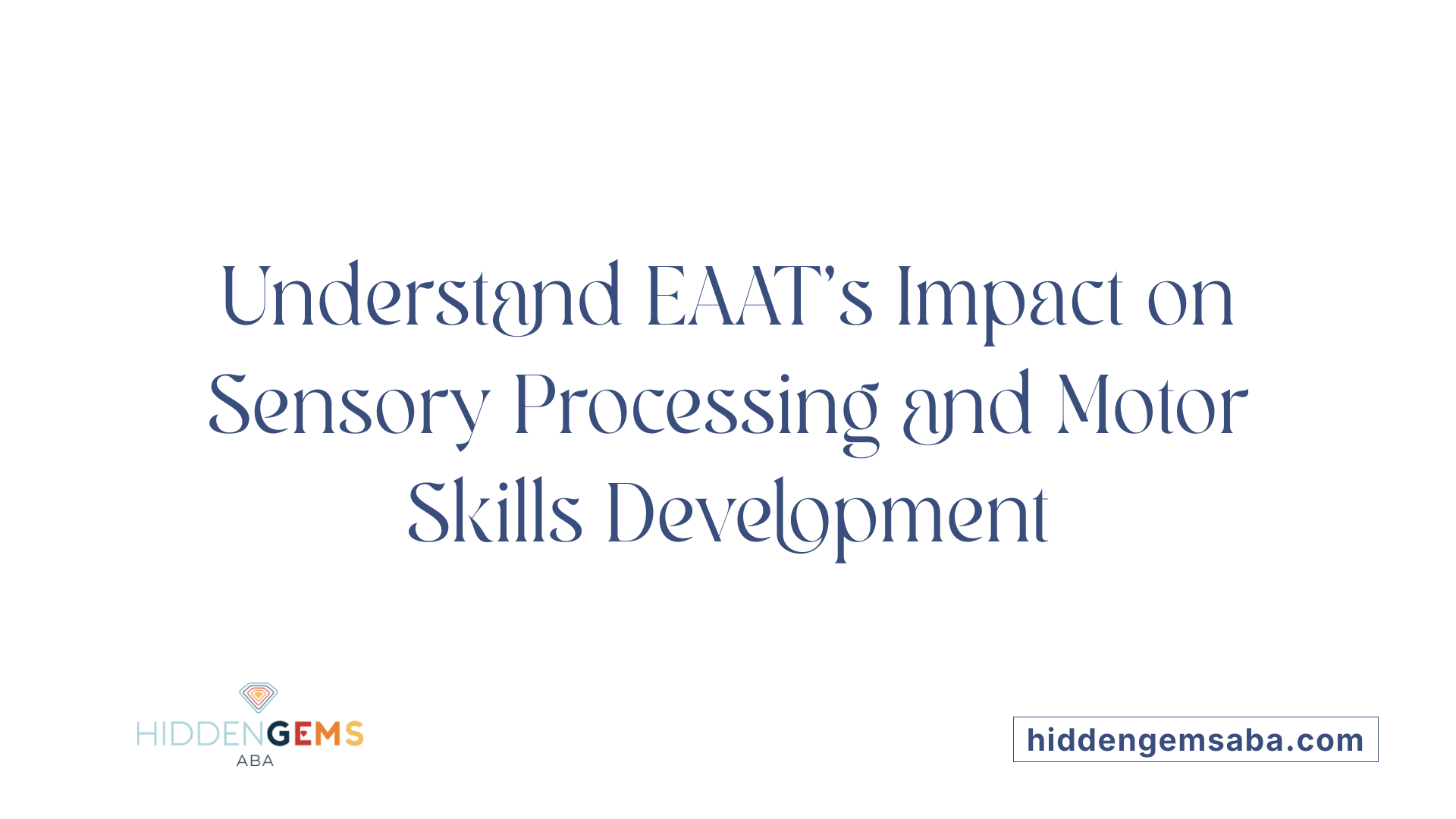
What positive effects have been observed in sensory processing?
Children with autism spectrum disorder (ASD) often experience challenges in sensory processing. Equine-assisted activities and therapies (EAAT) have shown promising positive effects in this area. Several studies report significant improvements in how children with ASD process sensory information after participating in EAAT programs. These improvements can help reduce sensory overload and improve daily functioning.
How do motor skills advance through EAAT?
Motor skill development is another area where EAAT has demonstrated benefits. Children engaging in these therapies have shown enhanced motor functions, which include better coordination, balance, and body awareness. The rhythmic movements of horseback riding and related activities appear to contribute to these motor skill advances, supporting physical development alongside psychosocial gains.
What are the limitations and what further research is needed?
Despite these encouraging findings, the evidence base is limited in scope and size. Many studies have small participant groups and varied methodologies, making it difficult to draw firm conclusions. There is a need for more rigorous, controlled research with larger sample sizes to validate and expand upon the observed benefits in motor and sensory functions. This would assist in understanding the full potential of EAAT for children with ASD and optimizing intervention strategies.
Impact of EAAT on Family Dynamics and Parental Stress

How does EAAT affect family functioning?
Several studies have reported improvements in family dynamics as a result of children with ASD participating in Equine-Assisted Activities and Therapies (EAAT). Families often describe better communication and increased emotional closeness following their child’s involvement in EAAT programs. These positive shifts may stem from the child’s enhanced social interaction and emotional regulation abilities, which can reduce household tensions and improve overall family cohesion.
Are there reductions in parental stress levels during or after EAAT?
Some evidence indicates that parental stress decreases following their child's participation in EAAT. For instance, certain studies have noted lowered stress markers in parents, possibly linked to observed behavioral improvements in their children. Additionally, physiological measures such as reductions in cortisol levels in participants suggest a stress-relieving effect, which may indirectly benefit family members' wellbeing. Nevertheless, this evidence remains somewhat inconsistent across different studies.
What are the limitations and variability in current findings?
The current body of research on family impact from EAAT shows mixed results. While there are reports of improved family functioning and reduced parental stress, the evidence is limited and not uniformly consistent. Many studies have small sample sizes or methodological constraints, such as lack of control groups or blinding, reducing the strength of conclusions. More rigorous, larger-scale research is necessary to better understand the extent and durability of these family-related benefits.
| Aspect | Observed Effects | Evidence Quality and Notes |
|---|---|---|
| Family Functioning | Improved communication and closeness | Based on qualitative reports, limited quantitative data |
| Parental Stress Levels | Some reductions noted | Inconsistent findings; small sample sizes |
| Research Limitations | Variability among studies | Need for larger, controlled trials |
Scientific Assessment Tools Used in EAAT Research

What is the Social Responsiveness Scale (SRS)?
The Social Responsiveness Scale (SRS) is a widely used tool to measure social behavior impairments associated with autism spectrum disorder (ASD). It assesses social awareness, cognition, communication, motivation, and repetitive behaviors. In EAAT studies, the SRS consistently shows improvements in social functioning following interventions, including therapeutic horseback riding (THR).
How is the Aberrant Behavior Checklist-Community (ABC-C) utilized?
The ABC-C is designed to evaluate behavioral issues such as irritability, hyperactivity, and social withdrawal. It is frequently applied in studies on children with ASD participating in EAAT programs. Research, including randomized controlled trials, has documented reductions in irritability and hyperactivity after THR using the ABC-C, highlighting its value in assessing behavioral regulation.
What role do Vineland Adaptive Behavior Scales and sensory profiles play?
Vineland Adaptive Behavior Scales measure adaptive behaviors, including communication, daily living skills, and socialization. Sensory profiles assess sensory processing differences common in children with ASD. These tools have identified positive changes in adaptive behavior and sensory processing post-EAAT, supporting claims of improved motor and sensory functions despite the limited number of studies.
Are these assessment tools showing consistent improvements?
Yes, across multiple studies, these scientific tools demonstrate consistent improvements in social and behavioral domains following EAAT. While quantitative evidence highlights progress in social cognition, communication, and behavioral regulation, some variability exists, revealing the necessity for ongoing rigorous research to strengthen these findings.
Highlights from Controlled Trials on Therapeutic Horseback Riding
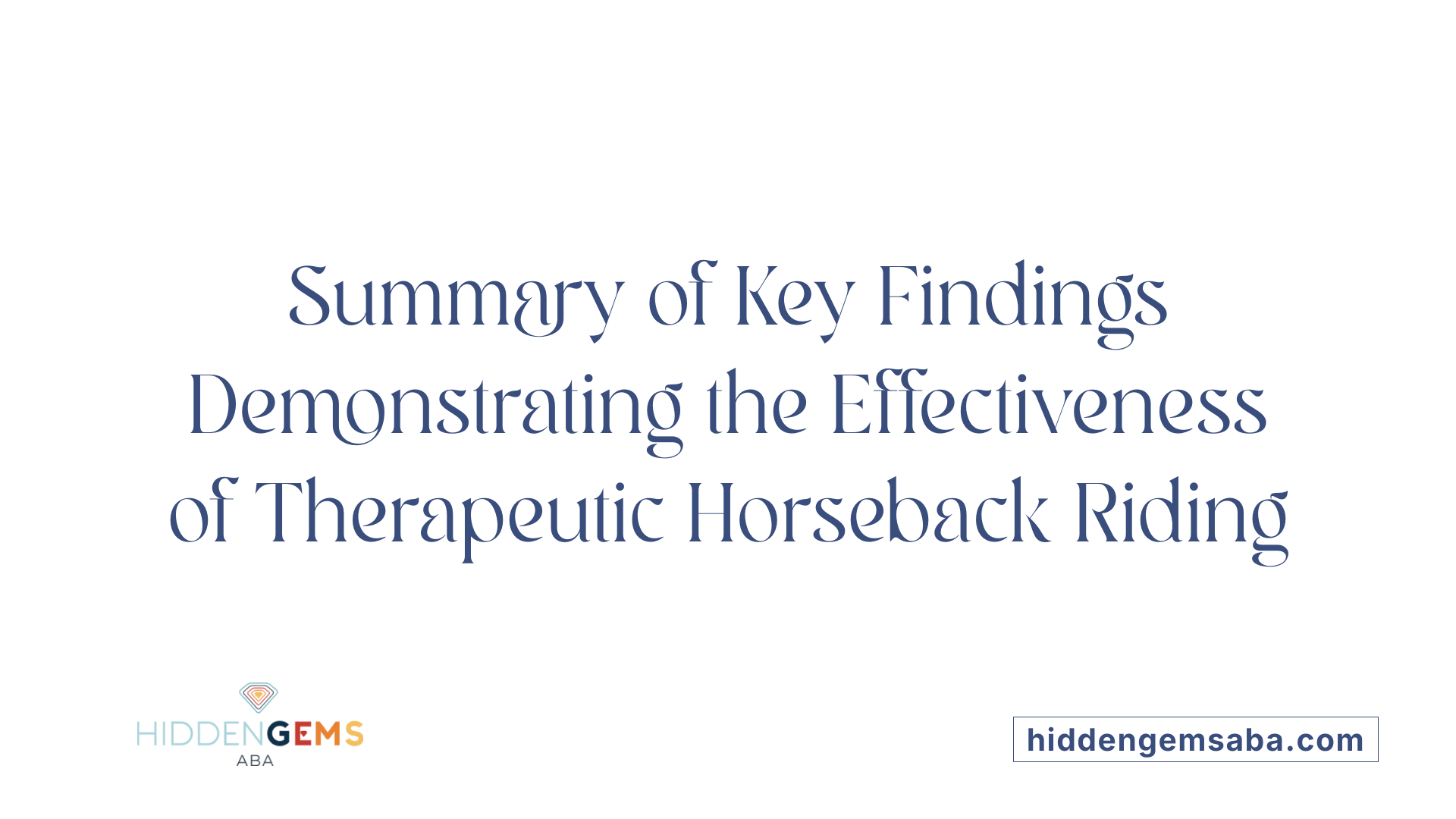
Randomized Controlled Trial Involving 116 Participants
A robust randomized controlled trial (RCT) examined the effects of therapeutic horseback riding (THR) on children with autism spectrum disorder (ASD). This study included 116 children aged 6 to 16 years, providing an adequately sized cohort to evaluate behavioral and social outcomes reliably.
Significant Improvements in Irritability, Hyperactivity, Social, and Communication Behaviors
After 10 weeks of THR intervention, participants demonstrated statistically significant improvements across multiple behavioral domains. Notably, irritability and hyperactivity showed marked reductions. Social and communication behaviors also improved, with increases in the number of words spoken and more positive social interactions reported.
Use of Validated Assessment Measures
The study employed well-established assessment tools, including the Aberrant Behavior Checklist-Community (ABC-C) and the Social Responsiveness Scale (SRS). These standardized measures ensured objective evaluation of behavioral changes and social responsiveness, strengthening the credibility of the findings.
Sustained Improvements Over Six Months
Follow-up assessments revealed that some of these gains, particularly in irritability and social-communication skills, were maintained for at least six months post-intervention. This highlights THR’s potential for producing lasting benefits in core challenges faced by children with ASD.
In summary, this controlled trial underscores therapeutic horseback riding as a promising complementary intervention that can reduce arousal and stress while enhancing key behavioral and social functions in youth with autism.
Long-Term Benefits and Potential Mechanisms of EAAT

Possible reduction in arousal states
Equine-Assisted Activities and Therapies (EAAT), such as Therapeutic Horseback Riding (THR), have been linked to a reduction in arousal states for children with autism spectrum disorder (ASD). The calming effects of horseback riding are believed to help regulate physiological responses, potentially lowering hyperactivity and irritability. This reduction in arousal may contribute to the observed behavioral improvements, promoting better emotional regulation.
Stress and anxiety alleviation
Several studies report that EAAT can alleviate stress and anxiety in youth with ASD. Physiological measures, including lowered cortisol levels after interventions, provide biological evidence supporting stress reduction. By engaging with horses and the therapeutic environment, children may experience a soothing effect that complements traditional psychological therapies aimed at anxiety management.
Sustained social and communication benefits
Longitudinal data from randomized controlled trials highlight that improvements in social interaction and communication skills can persist for at least six months following EAAT programs. Participants demonstrated sustained increases in the number of words spoken and enhanced social responsiveness, which are vital for their ongoing development and adaptive functioning.
How equine therapy may complement other interventions
EAAT’s unique combination of physical activity, sensory stimulation, and social interaction offers a multi-dimensional approach. As a complementary therapy, it may enhance the effectiveness of conventional interventions by addressing core challenges such as social deficits and behavioral regulation from different angles. The multisensory experience and emotional bonding present in EAAT can support and amplify progress achieved through traditional therapies.
Together, these long-term benefits and underlying mechanisms suggest that EAAT can play an important role in holistic treatment plans for children with ASD, providing both immediate and enduring support in core areas of development.
Applied Behavior Analysis (ABA) Therapy Explained
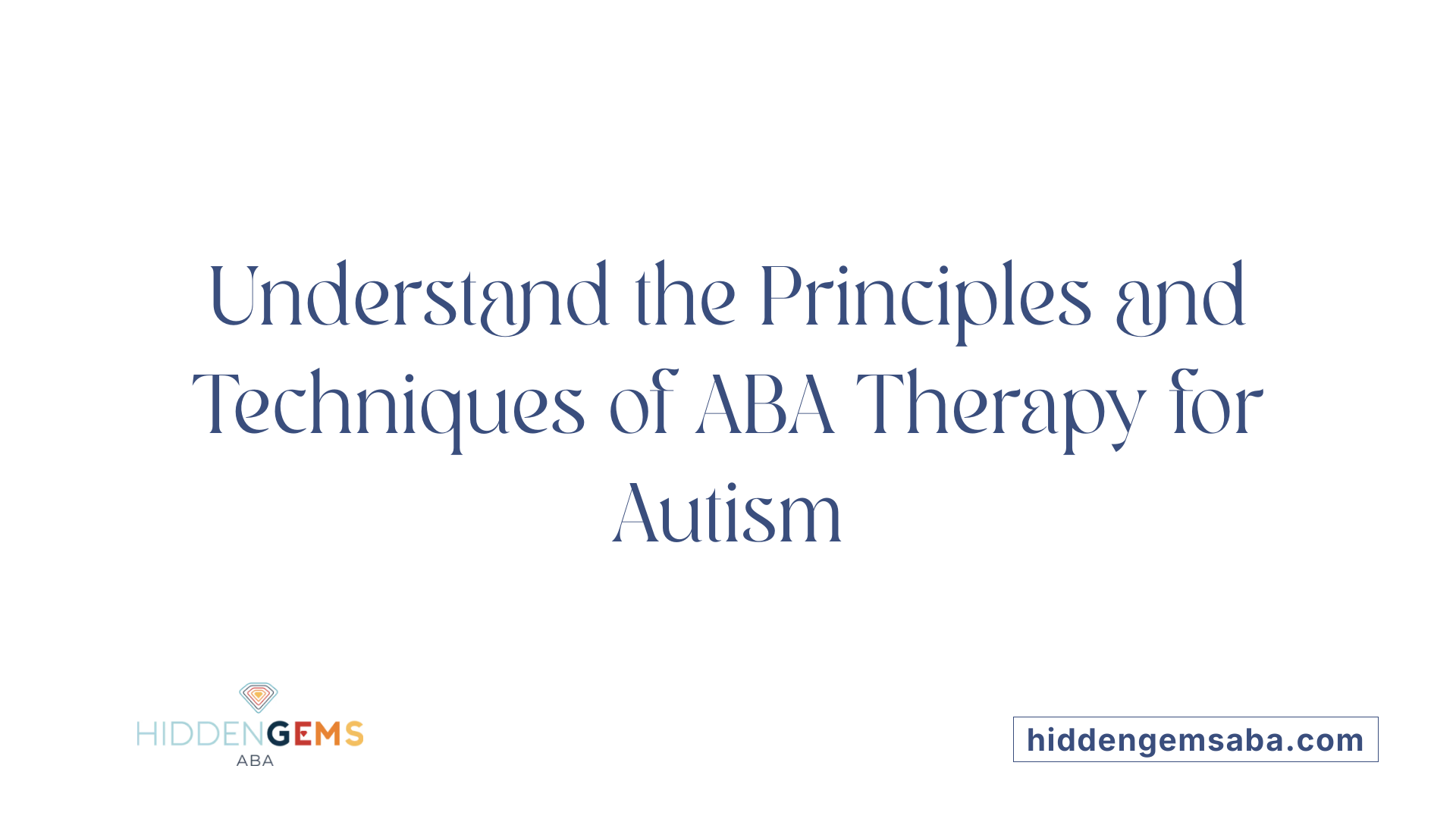
What is Applied Behavior Analysis (ABA) therapy?
Applied Behavior Analysis (ABA) therapy is a scientifically backed approach that studies how learning principles can help modify and improve behavior. This method focuses on increasing positive behaviors such as communication, social skills, and independence, while decreasing behaviors that are harmful or disruptive. ABA programs are designed to be highly individualized, ensuring that interventions specifically address the unique needs of each person.
The foundation of ABA lies in understanding behavior through learning principles like reinforcement (rewarding good behavior) and consequences (discouraging unwanted behavior). Therapists carefully assess the individual's skills and challenges to create a tailored plan.
Focus on learning principles and behavior modification
Central to ABA therapy is the application of learning theories. Positive behaviors are encouraged through reinforcement, such as praise or tangible rewards, and undesirable behaviors are reduced by modifying how situations are structured or responses are reinforced. This systematic approach makes learning new skills achievable and measurable.
Individualized intervention and tailoring to specific needs
ABA interventions are not one-size-fits-all. Each therapy plan targets skills relevant to the individual's language, attention, academic performance, or daily living activities. These targeted goals ensure that progress is meaningful and functional.
Techniques such as discrete trial training and reinforcement
One key technique used in ABA is discrete trial training (DTT), which breaks skills down into small, manageable steps and teaches them through repeated practice and reinforcement. Other methods include modeling (demonstrating behaviors) and developing reinforcement systems to motivate and sustain learning.
Importance of trained professionals in delivery
The success of ABA therapy depends greatly on the expertise of professionals delivering it. Board-Certified Behavior Analysts (BCBAs) and other trained therapists are essential in assessing needs, designing effective interventions, and monitoring progress. Their guidance ensures therapy is both effective and ethical.
Overall, ABA therapy offers a structured and evidence-based path to help individuals with autism develop essential skills and improve their quality of life.
Benefits of ABA Therapy for Individuals with Autism
How does ABA therapy benefit individuals with autism?
Applied Behavior Analysis (ABA) therapy offers numerous benefits for individuals with autism. It significantly enhances communication, social skills, and daily living abilities, enabling greater independence and functional participation in everyday settings. Through the use of positive reinforcement and personalized strategies, ABA increases desirable behaviors and reduces harmful or disruptive actions.
Improvements in communication, social, and daily living skills
ABA therapy targets crucial skill areas such as verbal communication and social interaction. By breaking down tasks into manageable steps and rewarding progress, individuals often see improvements in expressing needs, understanding social cues, and performing routine tasks independently.
Support for independence and functional participation
One of ABA’s strengths is its focus on practical life skills, which helps individuals with autism perform activities of daily living and participate more fully in school, home, and community life. The therapy fosters autonomy by teaching adaptive behaviors that promote self-care and appropriate social conduct.
Use of positive reinforcement and tailored strategies
ABA employs evidence-based techniques such as positive reinforcement to encourage learning and engagement. Each intervention plan is customized to the individual's unique strengths and challenges, ensuring highly effective outcomes.
Early intensive intervention outcomes
When ABA therapy is initiated early and delivered intensively, children show substantial progress in key developmental areas. This early support often results in improved cognitive, social, and adaptive functioning, which can enable entrance into mainstream educational settings.
Enhancement of socialization and emotional regulation
The therapy also promotes socialization and emotional regulation skills. By helping individuals recognize and manage emotions, engage appropriately with others, and respond flexibly to social situations, ABA therapy contributes to overall psychological well-being.
Endorsement as an evidence-based practice
ABA therapy is widely recognized as an evidence-based treatment by leading health organizations. Its flexible and individualized approach has made it a gold standard for supporting people with autism in reaching their full potential and improving quality of life.
Qualified Providers of ABA Therapy
Who typically provides ABA therapy?
ABA therapy is typically delivered by a team of trained professionals who possess specialized knowledge in behavioral analysis and autism intervention. The primary providers are Board Certified Behavior Analysts (BCBAs) and Board Certified Assistant Behavior Analysts (BCaBAs). These clinicians design and oversee individualized treatment plans, ensuring they are evidence-based and ethically sound.
Alongside BCBAs and BCaBAs, behavior technicians and therapists with specialized training carry out direct therapy sessions. These practitioners implement intervention strategies, collect data, and monitor progress under supervision. Their hands-on role is crucial for the consistent and effective delivery of ABA techniques.
Settings of ABA therapy delivery
ABA therapy can be provided in various settings including specialized clinics, private practices, schools, and the individual's home environment. This flexibility allows interventions to be contextually relevant and promotes generalization of skills across settings.
Family and caregiver involvement
The involvement of family members and caregivers is integral to the success of ABA therapy. Providers often train families to reinforce newly learned skills outside therapy sessions, enhancing the consistency and sustainability of behavioral gains.
Importance of evidence-based ethical practice
It is essential that ABA providers adhere to ethical guidelines and implement interventions supported by scientific research. Qualified practitioners tailor strategies to meet the unique needs of each individual, maintaining respect for the client’s dignity and promoting positive outcomes.
Techniques Commonly Employed in ABA Therapy
What techniques are commonly used in ABA therapy?
Applied Behavior Analysis (ABA) therapy relies on several techniques designed to promote learning and improve behavior in children with autism spectrum disorder (ASD). One of the most widely applied methods is positive reinforcement, where rewarding desirable behaviors encourages their repetition.
Another core method is Discrete Trial Training (DTT). This technique uses structured, repetitive trials to teach specific skills by breaking them down into small, manageable components. Each trial has a clear beginning and end, allowing children to practice skills in a focused way.
Natural Environment Teaching (NET) differs by focusing on learning within everyday settings and routines. This method helps children generalize skills beyond the clinical environment, encouraging more natural use of communication and social behaviors.
Behavior chaining and task analysis break complex behaviors into smaller steps. By teaching each step sequentially, children can build toward mastering more complicated skills.
Prompting and fading involve guiding a child’s behavior with prompts and gradually removing them as the child gains independence. This fosters skill acquisition without long-term reliance on assistance.
Additionally, modeling and social scripting provide examples and structured dialogues for social interaction, helping children understand and practice appropriate social behaviors.
Lastly, data collection and functional behavior assessment are crucial for tailoring interventions. Techniques like ABC analysis (Antecedent-Behavior-Consequence) allow therapists to understand the function of behaviors, enabling them to design effective strategies and monitor progress consistently.
Together, these methods offer a comprehensive approach to support children with ASD, addressing communication, social skills, and adaptive behaviors in a systematic way.
Comparing EAAT and ABA: Complementary Roles in Autism Intervention
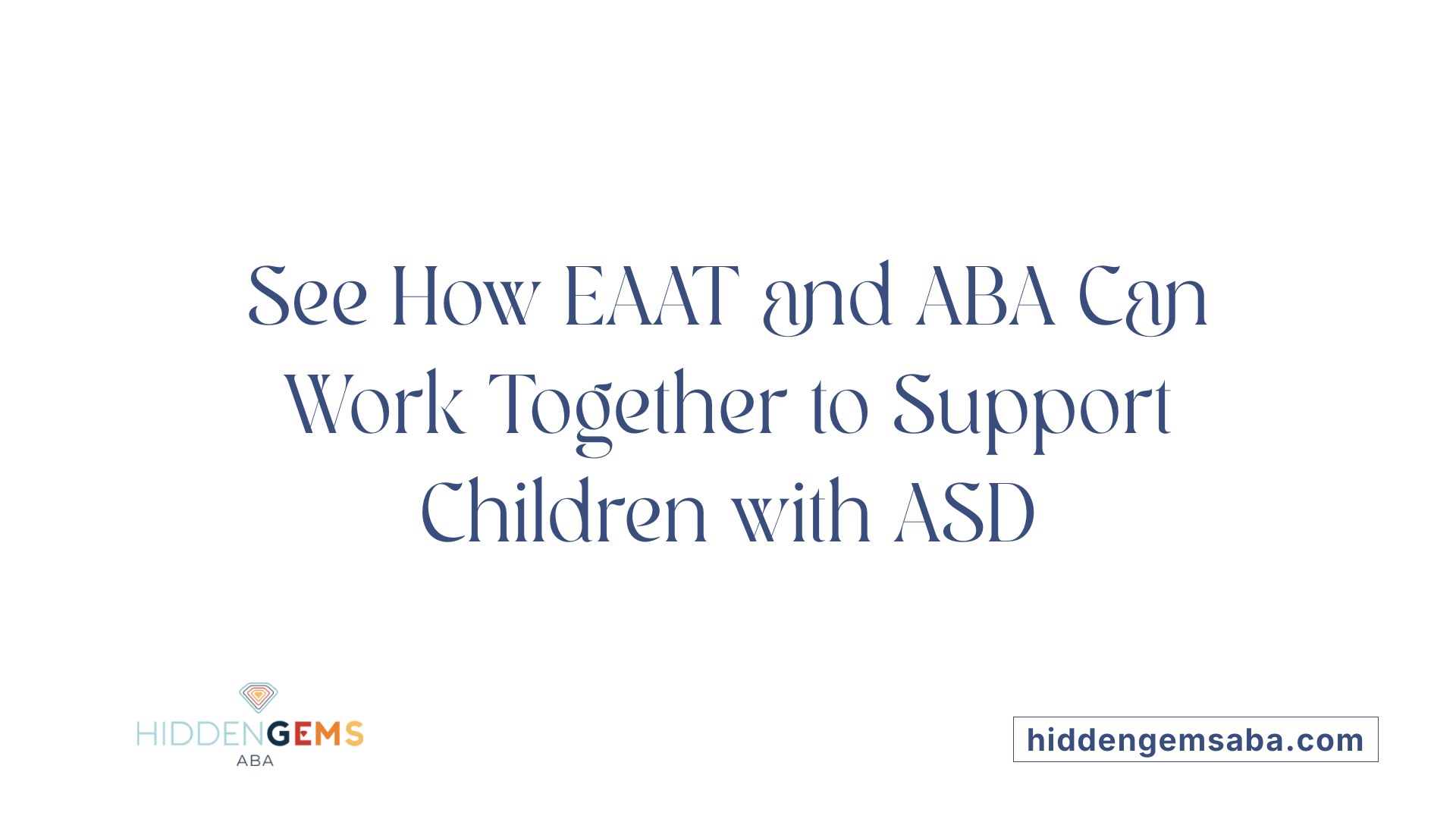
How EAAT Supports Social, Behavioral, and Sensory Development
Equine-Assisted Activities and Therapies (EAAT) have demonstrated considerable benefits in supporting children with Autism Spectrum Disorder (ASD). EAAT programs promote significant improvements in social interaction, communication, and emotional regulation. For example, therapeutic horseback riding (THR), a form of EAAT, has been shown to reduce irritability and hyperactivity, while also increasing social engagement, including the number of words spoken by participants. Motor skills and sensory processing also improve during these interventions, albeit based on limited evidence. Additionally, physiological markers such as cortisol levels suggest reduced stress following EAAT involvement.
ABA's Evidence-Based Structured Behavioral Approach
Applied Behavior Analysis (ABA) is a well-established, evidence-based therapy focusing on structured behavioral interventions. ABA targets skill acquisition and behavior modification using discrete, measurable goals and reinforcement techniques. It typically involves individualized programming that systematically shapes social, communicative, and adaptive behaviors in children with ASD. Unlike the more holistic and experience-based EAAT, ABA is characterized by its data-driven, highly structured framework aimed at consistent behavioral change and the development of functional skills.
Synergies Between Equine Therapy and ABA Benefits
The therapeutic effects of EAAT and ABA can complement one another. Whereas ABA emphasizes repetitive skill-building in controlled environments, EAAT leverages engaging, real-world animal-assisted settings to enhance motivation and emotional regulation. EAAT’s improvements in sensory and motor functions can facilitate ABA’s learning processes by decreasing maladaptive behaviors and increasing attention span. Furthermore, EAAT’s stress reduction potentially prepares children for more focused engagement during ABA sessions. Together, they address both the emotional and functional aspects of ASD.
Use of EAAT as Supplementary Therapy Alongside ABA
Given the complementary nature of these interventions, EAAT is often considered a valuable supplementary therapy alongside mainstream ABA programs. While ABA remains foundational, integrating EAAT offers additional opportunities for socialization, communication, and behavioral regulation in naturalistic contexts. Studies underline EAAT’s positive impact on social cognition and adaptive behaviors and suggest its role in sustaining long-term improvements in core ASD challenges. However, limitations such as study size and design encourage cautious optimism and emphasize the need for more rigorous research to refine combined treatment strategies.
Research Quality and Limitations in Equine Therapy Studies
Variability in study quality and methodologies
Research on Equine-Assisted Activities and Therapies (EAAT) for children with Autism Spectrum Disorder (ASD) shows promising results but suffers from considerable variability in study design. While some high-quality randomized controlled trials (RCTs) demonstrate significant benefits, many investigations use differing methodologies, resulting in difficulty comparing outcomes across studies.
Issues with small sample sizes, lack of blinding, and control groups
A common limitation among EAAT studies is small sample sizes, often involving fewer than 120 participants, which reduces statistical power. Additionally, since many studies lack blinding of participants and assessors, and at times do not include control groups, there is a higher risk of bias affecting the reported benefits. These design shortcomings weaken the generalizability of findings.
Need for rigorous future research to validate findings
Given these limitations, more rigorous future research is necessary. Larger, well-controlled RCTs with proper blinding procedures are needed to conclusively establish the effectiveness of EAAT. These studies would help confirm preliminary findings such as improvements in irritability, social communication, and behavioral regulation.
Challenges in standardizing EAAT protocols
Standardizing intervention protocols within EAAT presents challenges due to variation in therapy types, such as therapeutic horseback riding versus other equine-assisted activities. Differences in session frequency, duration, and therapist training further complicate replicability and comparison. Establishing uniform guidelines could improve consistency and clarity across studies.
Overall, while equine therapy shows potential as a supplemental intervention for children with ASD, current research limitations highlight the importance of cautious interpretation and the need for further high-quality studies.
Physiological Measures Indicating Stress Reduction in EAAT
Use of cortisol levels as a biological stress marker
Cortisol is a hormone commonly used to measure physiological stress levels. In research on children with autism spectrum disorder (ASD), cortisol serves as an objective biological marker to assess the effectiveness of therapeutic interventions, such as Equine-Assisted Activities and Therapies (EAAT), in reducing stress.
Evidence of cortisol reduction following EAAT sessions
Studies examining EAAT have utilized cortisol measurements before and after therapy sessions to evaluate stress changes. Some evidence indicates that participants experience a notable decrease in cortisol levels following EAAT interventions. This reduction suggests that EAAT may effectively lower physiological stress in children with ASD.
Implications for anxiety and arousal regulation in ASD
Lower cortisol levels post-EAAT point to potential benefits in regulating arousal and anxiety, common challenges among children with ASD. By reducing physiological stress, EAAT could complement other therapies aimed at improving emotional regulation and overall behavioral functioning. This stress reduction mechanism might partly explain the observed improvements in irritability and hyperactivity in affected children.
Participant Profiles in EAAT Research Studies
Age Ranges and Demographics Typically Studied
Research on Equine-Assisted Activities and Therapies (EAAT) for children with Autism Spectrum Disorder (ASD) commonly involves participants ranging in age from 3 to 16 years. For instance, a systematic review examining 15 studies included children across this age group, representing a span that captures early childhood through adolescence. Another notable randomized controlled trial (RCT) involved 116 participants aged 6 to 16 years, offering insights specifically into school-aged children.
Predominance of Male Participants
Most EAAT studies report a predominance of male participants, reflecting the higher diagnosed prevalence of ASD in males. The systematic review with 390 participants highlighted this trend, with the majority being male. This demographic balance aligns with general ASD population distributions and is consistent across multiple studies.
Focus on Psychosocial Functioning Outcomes
The primary focus of EAAT research is on psychosocial outcomes in children with ASD. Studies frequently assess improvements in social skills, communication, behavioral regulation, and emotional regulation. Measures such as socialization, engagement, and adaptive behaviors are common endpoints. Meta-analyses and RCTs often evaluate these domains using validated tools like the Social Responsiveness Scale (SRS) and the Aberrant Behavior Checklist-Community (ABC-C), emphasizing the therapies' impact on social cognition and behavioral adjustment.
Psychosocial Outcomes Observed in EAAT for Autism
How Does EAAT Help with Socialization and Engagement in Children with ASD?
Equine-Assisted Activities and Therapies (EAAT) have been found to substantially improve social functioning in children with autism spectrum disorder (ASD). These improvements are especially notable in social cognition and communication. Many participants exhibit better social interaction and engagement following EAAT programs, with enhancements documented through standardized measures such as the Social Responsiveness Scale (SRS).
What Behavioral Changes Occur with EAAT, Especially Regarding Maladaptive Behaviors?
EAAT is associated with notable reductions in maladaptive behaviors. Specifically, children with ASD often show decreases in irritability and hyperactivity after participating in therapeutic horseback riding or other equine-related interventions. These behavioral gains have been confirmed in randomized controlled trials, with some benefits maintained up to six months post-intervention.
Are There Improvements in Cognitive Functioning, Such as Problem-Solving?
Beyond social and behavioral growth, EAAT participants have demonstrated improved problem-solving reaction times. This suggests EAAT may enhance cognitive processing speed, contributing to better adaptability and daily functioning. However, while individual studies suggest these benefits, meta-analyses have yet to find universally statistically significant effects, highlighting variability across different investigations.
Why Do Meta-Analyses Show Mixed Results Regarding EAAT Effectiveness?
Although many individual studies report positive psychosocial outcomes, meta-analyses of EAAT for children with ASD reveal some inconsistency. Factors such as small sample sizes, differences in intervention protocols, and study design limitations may contribute to variable results. Consequently, while EAAT holds promise as a complementary therapy, further rigorous research is needed to establish definitive conclusions.
This overview highlights that EAAT supports socialization, reduces problematic behaviors, and may enhance cognitive skills in children with ASD, but the evidence shows some mixed findings likely due to the evolving nature of current research.
Future Directions and Potential of Equine Therapy in ASD Support
Encouraging early results and continued research needs
Equine-assisted activities and therapies (EAAT) have shown promising benefits in improving social functioning, behavioral regulation, and communication in children with autism spectrum disorder (ASD). Evidence from randomized controlled trials and meta-analyses highlights notable improvements in irritability, hyperactivity, social interaction, and language abilities. Despite these encouraging findings, variability in study quality, small sample sizes, and inconsistent results signal a critical need for further, more rigorous research.
Potential integration with mainstream autism therapies
Given the positive effects observed, there is growing interest in integrating EAAT as a complementary approach alongside conventional autism therapies. By targeting social cognition, emotional regulation, motor skills, and sensory processing, equine therapy can address multiple core and associated ASD challenges. Its unique, engaging, and multisensory environment may enhance participation and outcomes in traditional behavioral and developmental interventions.
Emerging role as a complementary intervention
Therapeutic horseback riding (THR) and other EAAT programs may reduce arousal and stress levels, as suggested by physiological indicators like cortisol. This stress reduction could underpin lasting behavioral improvements and emotional regulation, making EAAT a valuable adjunct therapy. These findings position equine therapy not only as a recreational activity but as a feasible supportive treatment with holistic benefits for children with ASD.
Call for larger, rigorous trials to establish efficacy
To solidify the role of EAAT, future studies must utilize larger sample sizes, control groups, and blinding to overcome current methodological limitations. Consistent use of validated outcome measures—such as the Social Responsiveness Scale, Aberrant Behavior Checklist, and Vineland Adaptive Behavior Scales—will enhance comparability and reliability. Such rigorous trials will help establish clear evidence of efficacy, define best practices, and support wider adoption in clinical and educational settings.
Towards a Holistic Approach to Autism Support
Equine-Assisted Activities and Therapies represent a promising adjunctive approach to traditional autism interventions, bringing unique benefits in social, behavioral, communication, sensory, and emotional domains. While Applied Behavior Analysis remains a highly validated, intensive therapy with broad skill-building capacities, EAAT adds the potential for stress reduction, motivational engagement, and motor-sensory integration. Together, these therapies may offer complementary pathways helping children with ASD reach improved quality of life and functional independence. Rigorous scientific investigation must continue to optimize protocol standardization, verify long-term effectiveness, and expand accessible programs for families seeking innovative autism supports.
References
- Effects of Equine-Assisted Activities and Therapies for ...
- Long-Term Effect of Therapeutic Horseback Riding in ...
- Equine assisted activities and therapies in children with ...
- Applied Behavior Analysis (ABA)
- Applied Behavior Analysis
- ABA Techniques: Strategies for Behavior Analysts - GSEP Blog
- Common ABA Therapy Strategies for Children With Autism
- Applied Behavior Analysis (ABA)
- 10 Common ABA Therapy Techniques
- Applied Behavior Analysis (ABA)


.avif)


